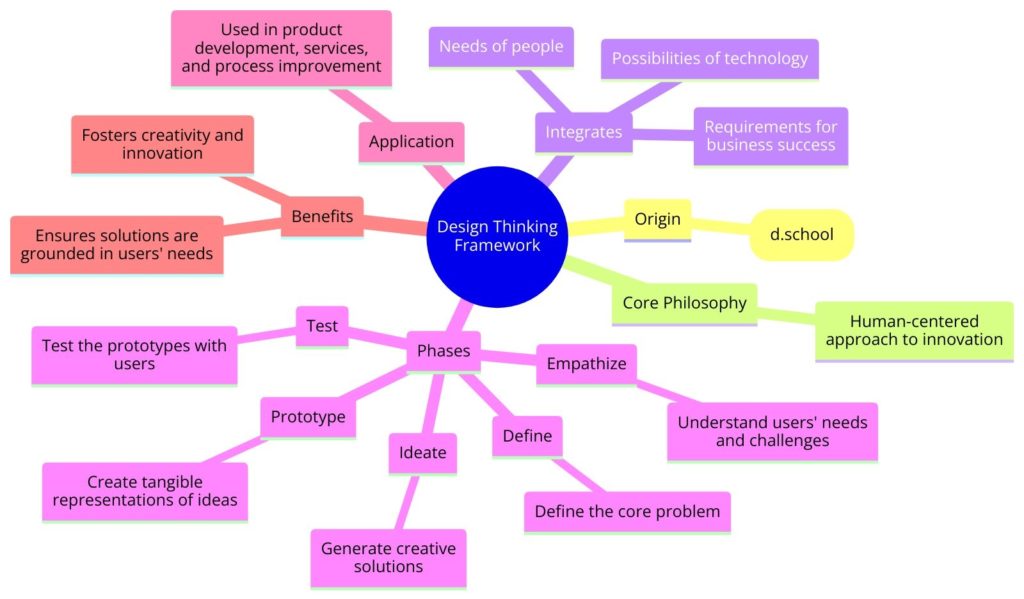Design Thinking Framework
The Design Thinking Framework developed by the Hasso Platner Institute of Design at Stanford University, commonly known as the d.school, is a human-centered approach to innovation that integrates the needs of people, the possibilities of technology, and the requirements for business success. This methodology is distinguished by its focus on empathizing with users, defining problems, ideating solutions, prototyping, and testing, and offering a structured approach to creativity and problem-solving that can be applied across various disciplines and industries.
What is the Design Thinking Framework?
The Design Thinking Framework is a process that encourages teams to focus on the people they’re creating for, leading to better products, services, and internal processes. It consists of five phases—Empathize, Define, Ideate, Prototype, and Test—though it’s non-linear and iterative, allowing designers to revisit and refine ideas and solutions continually.
Origin of the Framework
While the concept of design thinking has been around for decades, the specific framework developed by the d.school at Stanford University has played a crucial role in popularizing and formalizing the approach. The d.school was established by Hasso Plattner, co-founder of SAP, in 2005 with the aim of teaching design thinking as a method to solve complex problems in a user-centric way. The framework has since been adopted by organizations worldwide across various sectors.
How It Works
- Empathize: The first phase involves understanding the needs of those you’re designing for through observation, interaction, and immersing oneself in their experiences.
- Define: In this phase, you synthesize your observations about your users and define the core problems you have identified.
- Ideate: This phase involves generating a range of ideas and solutions through brainstorming sessions, challenging assumptions, and exploring different perspectives.
- Prototype: Prototyping involves creating tangible representations of your ideas to explore their potential and start bringing concepts to life.
- Test: The final phase involves testing your prototypes with users, gathering feedback, learning what works and what doesn’t, and refining your solutions accordingly.
Why It Is Valuable
The Design Thinking Framework offers several key advantages:
- User-Centricity: It ensures that the final product or solution is truly beneficial and desirable for the end-user by focusing on human needs from the outset.
- Flexibility: The framework can be applied to virtually any field or problem, from product design and engineering to healthcare and education.
- Collaboration and Diversity: It encourages multidisciplinary teamwork and leveraging diverse perspectives, leading to more innovative solutions.
- Iterative Learning: The iterative process of prototyping and testing allows for continuous refinement and learning, reducing the cost of failure.
When and How to Use It
Design Thinking can be used whenever you are facing a complex problem that requires a user-centric approach to solve. It is particularly effective for:
- Developing new products, services, or processes.
- Improving or innovating on existing products or services.
- Solving complex problems that lack a clear solution.
To use the framework effectively:
- Gather a diverse team to bring a range of perspectives to the process.
- Commit to the full cycle of the process, knowing that it may be necessary to loop back to earlier stages based on what you learn.
- Remain open-minded and ready to challenge your assumptions and learn from users.
Shortcomings/Criticisms
While widely celebrated, the Design Thinking Framework is not without its criticisms:
- Overemphasis on User Needs: Critics argue it may focus too much on user needs at the expense of other considerations like technical feasibility or business viability.
- Process Rigidity: Some see the framework as too rigid or linear, potentially stifling creativity and spontaneity.
- Implementation Challenges: Organizations sometimes struggle to integrate this human-centered approach into traditional business models and practices, which can limit its effectiveness.
The Design Thinking Framework from Stanford’s d.school offers a powerful approach to innovation that is user-centered, flexible, and collaborative. While it has transformed how many organizations approach problem-solving and development, it is most effective when adapted to fit the unique constraints and realities of each project and organization. Understanding its potential shortcomings and being willing to adapt the process can help maximize its benefits.


